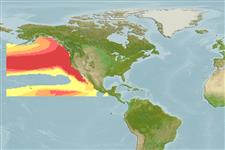Trachurus symmetricus (Ayres, 1855)
Pacific jack mackerel
Add your observation in Fish Watcher
| Native range | All suitable habitat | Point map | Year 2050 |

|
| This map was computer-generated and has not yet been reviewed. |
| Trachurus symmetricus AquaMaps Data sources: GBIF OBIS |
Upload your photos and videos
Pictures | Google imageTrachurus symmetricus
Picture by IGFA
Pictures | Google imageTrachurus symmetricus
Picture by IGFA
Common names from other countries
Classification / Names Common names | Synonyms | Catalog of Fishes(genus, species) | ITIS | CoL | WoRMS | Cloffa
Teleostei (teleosts) > Carangiformes (Jacks) > Carangidae (Jacks and pompanos) > Caranginae
Etymology: Trachurus: Greek, trachys, -eia, -ys = rough + Greek, oura = tail (Ref. 45335); symmetricus: From symmetricus which means regularly formed - referring to the rough tail (Ref. 6885).
More on author: Ayres.
Etymology: Trachurus: Greek, trachys, -eia, -ys = rough + Greek, oura = tail (Ref. 45335); symmetricus: From symmetricus which means regularly formed - referring to the rough tail (Ref. 6885).
More on author: Ayres.
Environment: milieu / climate zone / depth range / distribution range Ecology
Marine; pelagic-oceanic; oceanodromous (Ref. 51243); depth range 0 - 400 m. Subtropical; 65°N - 13°N
Distribution Countries | FAO areas | Ecosystems | Occurrences | Point map | Introductions | Faunafri
Eastern Pacific: southeastern Alaska to southern Baja California, Mexico and the Gulf of California; reported from Acapulco in Mexico and the Galapagos Islands.
Size / Weight / Age
Maturity: Lm ? range ? - 31 cm
Max length : 81.0 cm TL male/unsexed; (Ref. 2850); common length : 55.0 cm TL male/unsexed; (Ref. 9283); max. reported age: 30 years (Ref. 766)
Max length : 81.0 cm TL male/unsexed; (Ref. 2850); common length : 55.0 cm TL male/unsexed; (Ref. 9283); max. reported age: 30 years (Ref. 766)
Short description Identification keys | Morphology | Morphometrics
Dorsal spines (total): 8 - 9; Dorsal soft rays (total): 28 - 38; Anal spines: 1 - 2; Anal soft rays: 22 - 33; Vertebrae: 23 - 25. Small specimens may have an additional forward-directed spine at first dorsal origin (embedded in larger specimens).
Adults are often found offshore, up to 500 miles from the coast (Ref. 9283). They form large schools (Ref. 2850). Young frequently occur in school near kelp and under piers (Ref. 2850). They feed mainly on small crustaceans and fish larvae (Ref. 9283). Large individuals often move inshore and north in the summer (Ref. 2850). Marketed fresh, smoked, canned and frozen; eaten fried, broiled and baked (Ref. 9988).
Life cycle and mating behavior Maturity | Reproduction | Spawning | Eggs | Fecundity | Larvae
Main reference
Upload your references | References | Coordinator : Smith-Vaniz, William F. | Collaborators
Eschmeyer, W.N., E.S. Herald and H. Hammann, 1983. A field guide to Pacific coast fishes of North America. Boston (MA, USA): Houghton Mifflin Company. xii+336 p. (Ref. 2850)
IUCN Red List Status (Ref. 130435: Version 2024-2)
Least Concern (LC) ; Date assessed: 30 April 2008
Threat to humans
Harmless
Human uses
Fisheries: commercial; gamefish: yes
FAO(Fisheries: production; publication : search) | FishSource | Sea Around Us
More information
Population dynamics
Growth parameters
Max. ages / sizes
Length-weight rel.
Length-length rel.
Length-frequencies
Mass conversion
Recruitment
Abundance
Growth parameters
Max. ages / sizes
Length-weight rel.
Length-length rel.
Length-frequencies
Mass conversion
Recruitment
Abundance
Life cycle
Reproduction
Maturity
Fecundity
Spawning
Spawning aggregations
Eggs
Egg development
Larvae
Larval dynamics
Reproduction
Maturity
Fecundity
Spawning
Spawning aggregations
Eggs
Egg development
Larvae
Larval dynamics
Anatomy
Gill area
Brain
Otolith
Gill area
Brain
Otolith
Physiology
Body composition
Nutrients
Oxygen consumption
Swimming type
Swimming speed
Visual pigments
Fish sound
Diseases & Parasites
Toxicity (LC50s)
Body composition
Nutrients
Oxygen consumption
Swimming type
Swimming speed
Visual pigments
Fish sound
Diseases & Parasites
Toxicity (LC50s)
Genetics
Genetics
Heterozygosity
Heritability
Genetics
Heterozygosity
Heritability
Human related
Aquaculture systems
Aquaculture profiles
Strains
Ciguatera cases
Stamps, coins, misc.
Aquaculture systems
Aquaculture profiles
Strains
Ciguatera cases
Stamps, coins, misc.
Tools
E-book | Field guide | Length-frequency wizard | Life-history tool | Point map | Classification Tree
| Catch-MSY |
Special reports
Download XML
Internet sources
Aquatic Commons | BHL | Cloffa | BOLDSystems | Websites from users | Check FishWatcher | CISTI | Catalog of Fishes(genus, species) | DiscoverLife | ECOTOX | Faunafri | Fishtrace | GenBank(genome, nucleotide) | GloBI | GOBASE | | Google Books | Google Scholar | Google | IGFA World Record | MitoFish | Otolith Atlas of Taiwan Fishes | PubMed | Reef Life Survey | Scirus | SeaLifeBase | Tree of Life | Wikipedia(Go, Search) | World Records Freshwater Fishing | Zoological Record
Estimates based on models
Preferred temperature (Ref. 115969): 7 - 16.2, mean 9.2 (based on 50 cells).
Phylogenetic diversity index (Ref. 82804): PD50 = 0.5001 [Uniqueness, from 0.5 = low to 2.0 = high].
Bayesian length-weight: a=0.00955 (0.00581 - 0.01569), b=2.96 (2.82 - 3.10), in cm Total Length, based on LWR estimates for this species & Genus-body shape (Ref. 93245).
Trophic level (Ref. 69278): 3.6 ±0.2 se; based on diet studies.
Resilience (Ref. 120179): Low, minimum population doubling time 4.5 - 14 years (K=0.09-0.21;tm=2-3; tmax=30; Fec<50,000).
Fishing Vulnerability (Ref. 59153): High to very high vulnerability (66 of 100).
Climate Vulnerability (Ref. 125649): Moderate vulnerability (38 of 100).




